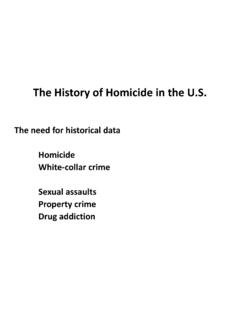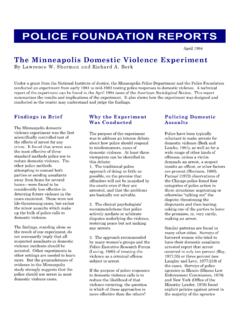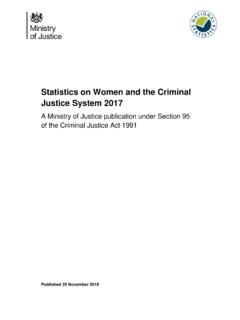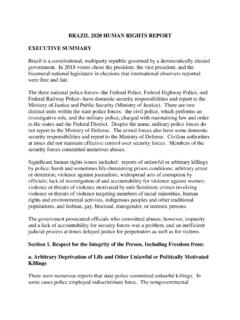Transcription of Domestic Homicide Reviews - GOV.UK
1 Domestic Homicide Reviews KEY FINDINGS FROM ANALYSIS OF Domestic Homicide Reviews December 2016 Domestic Homicide Reviews | 1 Contents 1 Introduction .. 2 2 Key Findings .. 3 General .. 3 Intimate Partner Homicide .. 3 Familial Homicide .. 3 3 Homicide Index: What we know about Domestic Homicide .. 5 4 Analysis of Domestic Homicide Reviews .. 7 5 Analysis of DHR recommendations .. 32 6 Supporting local areas to deliver a coordinated response to Domestic abuse .. 34 Annex A: Analysis of Homicide Index Additional Table .. 36 Annex B: Analysis of Domestic Homicide Reviews : detailed methodology .. 40 Annex C: Framework .. 42 Annex D: Attributes of familial Homicide DHRs.
2 44 Annex E: DHR coding results .. 43 Annex F: Further Reading .. 43 2 | Domestic Homicide Reviews 1 Introduction 1. A Domestic Homicide review (DHR) is a multi-agency review of the circumstances in which the death of a person aged 16 or over has, or appears to have, resulted from violence, abuse or neglect by a person to whom they were related or with whom they were, or had been, in an intimate personal relationship, or a member of the same household as themselves. Since 13 April 2011 there has been a statutory requirement for local areas to conduct a DHR following a Domestic Homicide that meets the criteria. 2. Since April 2011, in excess of 400 DHRs have been completed.
3 DHRs provide a rich source of information on the nature of Domestic Homicide , the context in which it occurs and, most importantly, in the lessons that can be learned from the tragic event. This analysis sets out what we know about Domestic Homicide and draws out common themes and trends and identifies learning that emerged across the sample of DHRs. 3. The purpose of this analysis is to promote key learning and trends from the sample of DHRs with the aim of informing and shaping future policy development and operational practice both locally and nationally. 4. We encourage local areas to reflect on the learning identified and to consider how this can be used to deliver improvements to practice within their local context furthering their ability to safeguard victims and prevent Domestic Homicide .
4 5. This paper also reports on what is being done nationally to tackle these issues. Domestic Homicide Reviews | 3 2 Key Findings Statistics General In 2014/15 there were 50 male and 107 female Domestic Homicide victims (which includes intimate partner homicides and familial homicides) aged 16 and over. Although the number of both male and female Domestic Homicide victims fluctuated from year to year, there is a clear downward trend. Among women, the majority of Domestic Homicide victims were killed by a partner / ex-partner. Among both men and women the highest proportion of Domestic homicides was among those aged 30 to 50 (around two-fifths). The most common method of killing for both male and female Domestic Homicide victims was by a knife or other sharp instrument.
5 The majority of principal suspects in Domestic Homicide cases were male (87% for combined years 2010/11 to 2014/15) and nearly one half were aged between 30 and 50 years old. Intimate Partner Homicide Of the 33 intimate partner homicides considered as part of this analysis, just under half (15 cases) included dependent children in the family structure. Mental health issues were present in 25 of the 33 intimate partner homicides. In just over half of all DHRs (21), substance use was mentioned. In 24 of the 33 intimate partner homicides, the perpetrator had a history of violence. In six cases the victim had a history of violence towards the perpetrator. Familial Homicide Of the 40 cases analysed, seven were familial homicides.
6 All involved a male perpetrator who committed the Homicide . Six of these cases involved the son killing a parent; in one case it was the father. Mental health issues were factors in all seven cases. Substance use by the perpetrator was also noted in all but one familial Homicide cases. 4 | Domestic Homicide Reviews Main Findings The most common theme occurring in intimate partner Homicide DHRs was record keeping. This was highlighted as an issue in 28 out of 33 (85%) intimate partner Homicide DHRs sampled. Risk assessment was the next most commonly occurring theme with 27 out of 33 DHRs (82%) highlighting this as an issue. Communication and information sharing between agencies was identified as an issue in 25 out of 33 (76%) DHRs sampled.
7 There were 24 cases (73% of those sampled) where victims or perpetrators presented to agencies with possible signs of Domestic abuse and/or Domestic violence but this was not recognised or explored further. Across the four years in which the DHRs in this sample were analysed, there were a total of 600 recommendations made by these DHRs. Although recommendations made to each agency will have been affected by the exact circumstances surrounding each DHR and the way in which recommendations were captured in DHRs, Community Safety Partnerships (CSP) and health bodies were identified as having the highest proportion of recommendations (both around a quarter of all recommendations) across the four years.
8 In 2013, agencies receiving the largest proportion of recommendations were in the health sector, in both 2014 and 2015 this was the CSP and in 2016 the highest proportion of recommendations was for the police. Across all four years, training was consistently the highest proportion of recommendations. Domestic Homicide Reviews | 5 3 Homicide Index: What we know about Domestic Homicide 6. Data presented here have been extracted from the Home Office Homicide Index, which contains detailed information about each Homicide recorded by police in England and Wales. It is continually updated with revised information from the police and the courts. 7. The term Homicide covers the offences of murder, manslaughter and infanticide.
9 However, it should be noted that the threshold for conducting a DHR is lower than the criminal threshold. A DHR should be conducted when the death of a person aged 16 or over has, or appears to have, resulted from violence, abuse or 1. So, for example, a DHR may be conducted on an apparent suicide, where it appears the suicide was caused by abuse, but such a case would not be logged in the Homicide Index. 8. Homicide Index data are based on the year when the offence was first recorded, not when the offence took place or when the case was heard in court. While in the vast majority of cases the offence will be recorded in the same year as it took place, this is not always the case.
10 The data refer to the position as at 13 November 2015, when the Homicide Index database was frozen in order for analysis to be conducted2. These data will change as subsequent court hearings take place or as other information is received. Domestic Homicide victims 9. The definition of Domestic Homicide used here approximates to that used in DHRs and includes victims killed by a partner/ex partner3 or a relative or by someone else living with the victim at the time of the killing. 10. In 2014/15, there were 50 male and 107 female Domestic Homicide victims aged 16 and over. 11. Figure 1 shows the trend in the number of Domestic homicides for men and women aged 16 and over since 2007/08.















